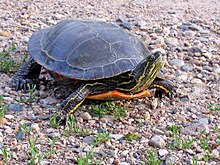
Back سلحفاة مزركشة Arabic سلحفاه مزركشه ARZ Петниста блатна костенурка Bulgarian নকশী কচ্ছপ Bengali/Bangla Tortuga pintada Catalan Chrysemys picta CEB Želva ozdobná Czech Zierschildkröte German Βαμμένη χελώνα Greek Chrysemys picta Esperanto
| Painted turtle | |
|---|---|

| |
| Western painted turtle | |
| Scientific classification | |
| Domain: | Eukaryota |
| Kingdom: | Animalia |
| Phylum: | Chordata |
| Class: | Reptilia |
| Order: | Testudines |
| Suborder: | Cryptodira |
| Superfamily: | Testudinoidea |
| Family: | Emydidae |
| Subfamily: | Deirochelyinae |
| Genus: | Chrysemys |
| Species: | C. picta
|
| Binomial name | |
| Chrysemys picta (Schneider, 1783)
| |
| Subspecies[3] | |

| |
| Yellow: Eastern (C. p. picta) Orange: Midland (C. p. marginata) | |
| Synonyms[6] | |
|
Species synonymy[4]
| |
The painted turtle (Chrysemys picta) is the most widespread native turtle of North America. It lives in relatively slow-moving fresh waters, from southern Canada to northern Mexico, and from the Atlantic to the Pacific. They have been shown to prefer large wetlands with long periods of inundation and emergent vegetation.[7] This species is one of the few that is specially adapted to tolerate freezing temperatures for extended periods of time due to an antifreeze-like substance in their blood that keeps their cells from freezing.[8] This turtle is a member of the genus Chrysemys, which is part of the pond turtle family Emydidae. Fossils show that the painted turtle existed 15 million years ago. Three regionally based subspecies (the eastern, midland, and western) evolved during the last ice age. The southern painted turtle (C. dorsalis) is alternately considered the only other species in Chrysemys, or another subspecies of C. picta.
The adult painted turtle is 13–25 cm (5–10 in) long; the male is smaller than the female. The turtle's top shell is dark and smooth, without a ridge. Its skin is olive to black with red, orange, or yellow stripes on its extremities. The subspecies can be distinguished by their shells: the eastern has straight-aligned top shell segments; the midland has a large gray mark on the bottom shell; the western has a red pattern on the bottom shell.
The turtle eats aquatic vegetation, algae, and small water creatures including insects, crustaceans, and fish. Painted turtles primarily feed while in water and are able to locate and subdue prey even in heavily clouded conditions.[9] Although they are frequently consumed as eggs or hatchlings by rodents, canines, and snakes, the adult turtles' hard shells protect them from most predators. Reliant on warmth from its surroundings, the painted turtle is active only during the day when it basks for hours on logs or rocks. During winter, the turtle hibernates, usually in the mud at the bottom of water bodies. The turtles mate in spring and autumn. Females dig nests on land and lay eggs between late spring and mid-summer. Hatched turtles grow until sexual maturity: 2–9 years for males, 6–16 for females.
In the traditional tales of Algonquian tribes, the colorful turtle played the part of a trickster. In modern times, four U.S. states (Colorado, Illinois, Michigan, and Vermont) have named the painted turtle their official reptile. While habitat loss and road killings have reduced the turtle's population, its ability to live in human-disturbed settings has helped it remain the most abundant turtle in North America. Adults in the wild can live for more than 55 years.
- ^ Ernst & Lovich 2009, pp. 184–185.
- ^ "Chrysemys picta". IUCN Red List of Threatened Species. Retrieved 2013-10-19.
- ^ a b c d Rhodin et al. 2010, p. 000.99.
- ^ a b Mann 2007, p. 6.
- ^ Cite error: The named reference
WCSU-Taxonomicwas invoked but never defined (see the help page). - ^ Fritz, Uwe; Peter Havaš (2007). "Checklist of Chelonians of the World". Vertebrate Zoology. 57 (2): 177–179. doi:10.3897/vz.57.e30895. S2CID 87809001.
- ^ Cosentino, Bradley (September 11, 2010). "Wetland hydrology, area, and isolation influence occupancy and spatial turnover of the painted turtle, Chrysemys picta". Landscape Ecology. 25 (10): 1589–1600. Bibcode:2010LaEco..25.1589C. doi:10.1007/s10980-010-9529-3. S2CID 38488888.
- ^ Gibbons, J. Whitfield (1968). "Population Structure and Survivorship in the Painted Turtle, Chrysemys picta". Copeia. 1968 (2): 260–268. doi:10.2307/1441752. ISSN 0045-8511. JSTOR 1441752.
- ^ Grosse, Andrew (1 September 2010). "Effects of turbidity on the foraging success of the eastern painted turtle". Copeia. 2010 (3): 463–467. doi:10.1643/CE-09-162. S2CID 83648930.
© MMXXIII Rich X Search. We shall prevail. All rights reserved. Rich X Search
